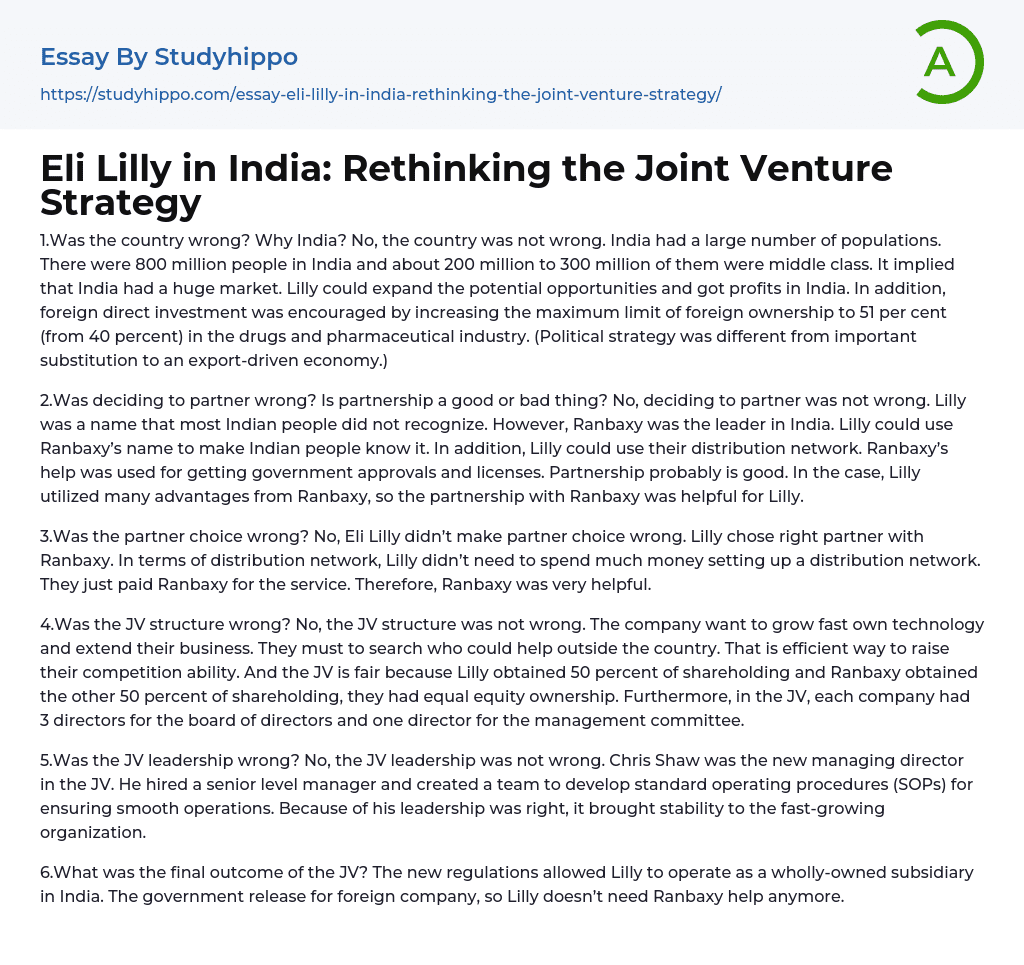

Eli Lilly in India: Rethinking the Joint Venture Strategy Essay Example
1.Was the country wrong? Why India? No, the country was not wrong. India had a large number of populations. There were 800 million people in India and about 200 million to 300 million of them were middle class. It implied that India had a huge market. Lilly could expand the potential opportunities and got profits in India. In addition, foreign direct investment was encouraged by increasing the maximum limit of foreign ownership to 51 per cent (from 40 percent) in the drugs and pharmaceutical industry. (Political strategy was different from important substitution to an export-driven economy.)
2.Was deciding to partner wrong? Is partnership a good or bad thing? No, deciding to partner was not wrong. Lilly was a name that most Indian people did not recognize. However, Ranbaxy was the leader in India. Lilly could use Ranbaxy’s name to make Indian people
...know it. In addition, Lilly could use their distribution network. Ranbaxy’s help was used for getting government approvals and licenses. Partnership probably is good. In the case, Lilly utilized many advantages from Ranbaxy, so the partnership with Ranbaxy was helpful for Lilly.
3.Was the partner choice wrong? No, Eli Lilly didn’t make partner choice wrong. Lilly chose right partner with Ranbaxy. In terms of distribution network, Lilly didn’t need to spend much money setting up a distribution network. They just paid Ranbaxy for the service. Therefore, Ranbaxy was very helpful.
4.Was the JV structure wrong? No, the JV structure was not wrong. The company want to grow fast own technology and extend their business. They must to search who could help outside the country. That is efficient way to raise their competition ability. And the JV
is fair because Lilly obtained 50 percent of shareholding and Ranbaxy obtained the other 50 percent of shareholding, they had equal equity ownership. Furthermore, in the JV, each company had 3 directors for the board of directors and one director for the management committee.
5.Was the JV leadership wrong? No, the JV leadership was not wrong. Chris Shaw was the new managing director in the JV. He hired a senior level manager and created a team to develop standard operating procedures (SOPs) for ensuring smooth operations. Because of his leadership was right, it brought stability to the fast-growing organization.
6.What was the final outcome of the JV? The new regulations allowed Lilly to operate as a wholly-owned subsidiary in India. The government release for foreign company, so Lilly doesn’t need Ranbaxy help anymore.
- Being A Leader essays
- Servant Leadership essays
- Leadership Experience essays
- Leadership Qualities essays
- Competition essays
- Effective Leadership essays
- Leadership Styles essays
- Public relations essays
- Planning essays
- Mission Statement essays
- Outsourcing essays
- Swot Analysis essays
- Business Analysis essays
- Business Plan essays
- Strategic Management essays
- Strategic Planning essays
- Reasoning essays
- Community Development essays
- Negotiation essays
- Board Of Directors essays
- Brand Management essays
- Business Ethics essays
- Business Management essays
- Change Management essays
- Comparative Analysis essays
- Decision Making essays
- Dispute Resolution essays
- Knowledge Management essays
- Leadership essays
- Leadership and Management essays
- Manager essays
- Operations Management essays
- Performance Management essays
- Product Management essays
- Project Management essays
- Quality Management essays
- Risk essays
- Risk Management essays
- Scientific Management essays
- Stress Management essays
- supply chain management essays
- Time Management essays
- Total Quality Management essays
- Bangladesh essays
- China essays
- Hong Kong essays
- India essays
- Japan essays
- Kuala Lumpur essays
- Malaysia essays



